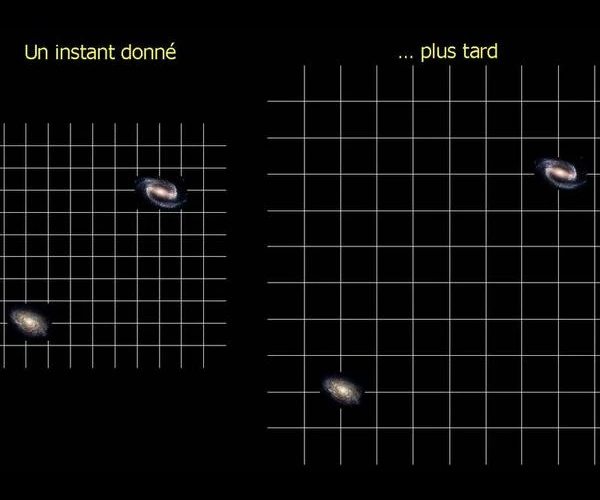
Image Description: Accelerated Expansion of the Universe
At the heart of contemporary debates in cosmology is an astonishing phenomenon: the accelerated expansion of the universe. Discovered in the late 1990s, this revelation has transformed our understanding of cosmic dynamics and led to the proposal of a new mysterious component of the universe: dark energy.
The idea that the universe is expanding dates back to the work of Edwin Hubble, who, in the 1920s, demonstrated that galaxies are moving away from us and that the speed at which they are receding is proportional to their distance. This phenomenon is described by Hubble's law, which established that the universe is expanding, a concept corroborated by the equations of general relativity from Albert Einstein.
In the mid-1990s, two independent teams of astronomers, the Supernova Cosmology Project (SCP) and the High-Z Supernova Search Team, began observing Type Ia supernovae, which are characteristic stellar explosions. These supernovae are used as standard candles due to their relatively constant intrinsic brightness.
The astronomers measured the apparent brightness of these supernovae and, by comparing them to their intrinsic brightness, were able to determine their distance. Simultaneously, they measured the redshift of these supernovae to calculate their recession velocity. These measurements revealed an unexpected result: distant supernovae appeared dimmer than expected in a model of a decelerating expanding universe, indicating that they were receding faster than anticipated.
This finding led to the conclusion that the expansion of the universe was not slowing down, as previously thought, but rather accelerating. This led to the introduction of the concept of dark energy, a mysterious form of energy that constitutes about 68% of the universe and exerts negative pressure, promoting the acceleration of expansion.
Dark energy has been integrated into cosmological models through the cosmological constant (Lambda), which appeared in Einstein's equations. This term, originally introduced to allow for a static universe model, has been rediscovered to explain the acceleration of expansion.
Cosmologists have proposed different models to describe dark energy:
In addition to supernovae, several other observations support the idea of accelerated expansion:
We do not yet know the true nature of dark energy and the acceleration of the universe's expansion. Physicists are attempting to test these two paradigms capable of explaining the observations, that of dark energy and that of modified gravity. This would allow the elimination of a group of theories. The Euclid or SKA missions will help to distinguish between these two groups of theories.
Professor Camille Bonvin, a professor at the University of Geneva, has developed a method to test these two paradigms. It involves comparing the distortion of time and the distortion of space, generated by the galaxies and clusters present in the Universe. Einstein's general relativity predicts that these two distortions are equal, unlike alternative gravity theories where, generally, these distortions differ.
Testing the validity of Einstein's theory at the farthest reaches of the Universe is undoubtedly one of the great challenges of tomorrow's cosmology.
N.B.:
Euclid is the space mission selected by the ESA (scheduled for 2023) that could provide answers regarding the true nature of the Universe. Euclid will probe the history of the expansion of the Universe and the formation of cosmic structures. The goal is to measure the distribution of matter in the universe and how this distribution has evolved since the Big Bang. The name of the mission was chosen in honor of Euclid (300 BC), the Greek mathematician considered the father of geometry.